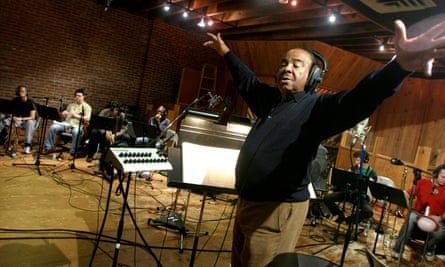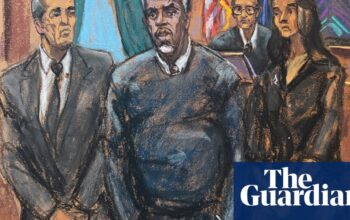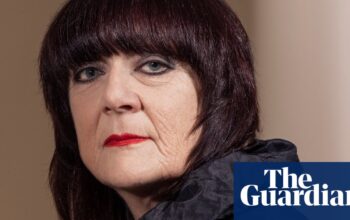When the photographer Art Kane trained his lens on a group of 57 assorted jazz musicians in front of a brownstone house in Harlem one day in the summer of 1958, what he saw represented almost the entire history of the idiom. Early masters such as the trumpeter Red Allen and the drummer Zutty Singleton were mingling with the swing-era heroes Count Basie, Lester Young and Gene Krupa, and with postwar beboppers such as Thelonious Monk and Dizzy Gillespie.
Among the youngest of the assembly – not counting the neighbourhood children who sat on the kerb in front of the musicians – was the tenor saxophonist and composer Benny Golson, already the author of jazz standards such as Whisper Not and I Remember Clifford, who has died aged 95.
Golson’s death leaves his fellow tenorist, Sonny Rollins, now 94, as the only survivor of the tableau vivant on East 126th Street that became known as A Great Day in Harlem. First published in Esquire magazine, the photograph inspired a 1994 documentary and then a feature film, The Terminal, directed by Steven Spielberg in 2004 and starring Tom Hanks as a man searching for Golson, who had a cameo role playing himself.
After building a reputation in the New York jazz scene during the 1950s, notably as a member of Art Blakey’s Jazz Messengers, Golson put down his instrument and moved to Hollywood, where he spent a decade writing scores for TV series, including Mission: Impossible, Mannix, The Mod Squad, The Partridge Family and M*A*S*H.
Disappointed by the lack of dramatic range in the work he was being offered, he returned to New York in the 70s. Having refamiliarised himself with the saxophone he built a second and successful performing career in clubs and at festivals around the world, eventually becoming one of jazz’s revered elders.
Born in Philadelphia, he was christened Bennie after his father, who left the family when he was small. Golson later amended the spelling. He was brought up by his mother, Celadia, who worked as a seamstress by day and a waitress at night and took in boarders to provide for the family.
At eight years old he encountered overt racism for the first time during a trip to Georgia, witnessing his uncle being threatened by a white policeman whom he had addressed as “Bud” – not acceptable from a black man in the deep south in the 30s. Five years later he visited New York and was taken to Minton Playhouse, the wartime cradle of bebop, where that same uncle was working as a doorman. So at 13 he heard some of the bop pioneers, including Monk, making their discoveries in real time.
At Benjamin Franklin high school he developed his interest in music and had ambitions to become a concert pianist before taking up the saxophone and receiving his first instrument aged 14. Seeing the big-toned Texas tenorist Arnett Cobb starring with the Lionel Hampton Orchestra was one source of inspiration. Meeting John Coltrane, a fellow teenager, was another. Together they studied, practised daily, and began taking part in jam sessions.

One night they went to see a concert featuring Gillespie and Charlie Parker at the Academy of Music in Philadelphia and encountered a vision of the future. “We didn’t know it then, but our musical world changed that night,” Golson wrote in his autobiography, Whisper Not (2016).
While Coltrane embarked on a fully professional career with the bands of Gillespie and Johnny Hodges, Golson enrolled at Howard University in Washington DC, although soon he too was on the road, recruited by the popular R&B singer and saxophonist Bull Moose Jackson. The band’s pianist and arranger was Tadd Dameron, a slightly older man who took Golson under his wing and showed him how even the most advanced jazz of the time could be given melodic appeal.
Now based in New York, Golson found work with the bands of Hampton, Gillespie and Earl Bostic. When Coltrane joined Miles Davis’s quintet in 1955, he took with him one of Golson’s early tunes, Stablemates. When Davis recorded it, the world was alerted to the composer’s gifts. Soon his tune Blues Walk was being recorded by the popular saxophonist James Moody, while Gillespie recorded Whisper Not.
In 1957 Golson won two awards in Down Beat magazine’s annual poll, as the “new star” tenor saxophonist and arranger. In 1958 he joined the Jazz Messengers as musical director, providing Blakey’s quintet – which also included the gifted young Philadelphian trumpeter Lee Morgan – with tunes for their Blue Note label albums, including Along Came Betty, Whisper Not, Just By Myself and I Remember Clifford, a lament for his late friend Clifford Brown, the trumpeter whose brilliant promise was brought to an end in a fatal car crash.
Building a reputation as an astute musical organiser, Golson supplied many of the tunes and arrangements for the sessions that produced Morgan’s first four albums on Blue Note in 1957 and 1958, all of them regarded as classics today. His own recording career began with an album titled Benny Golson’s New York Scene for the Contemporary label, The Modern Touch and The Other Side of Benny Golson for the Riverside label, and Benny Golson and the Philadelphians for United Artists, all recorded in 1958. They were followed by a series of albums for the New Jazz and Argo labels.
In 1959 he left Blakey to form the Jazztet, a sextet co-led with the trumpeter Art Farmer, another kindred spirit. The group’s first gig was at a Manhattan club called the Half Note, sharing the bill with the quartet of the controversial saxophonist Ornette Coleman, making his New York debut. While Leonard Bernstein and others came to listen and assess Coleman’s revolutionary music, Golson’s band was completely overlooked. Nevertheless it continued until 1962, its qualities more widely appreciated 20 years later when Golson and Farmer formed a new group under the same name, performing intermittently until Farmer’s death in 1999.
Golson’s own playing, characterised by a distinctively fibrous, slightly hoarse tone, seemed firmly within the mainstream-modern tradition exemplified by another of his heroes, the tenorist Don Byas. During the 60s he absorbed some of the techniques pioneered by Coltrane, a friend he called “an inextinguishable example of spiritual nobility”, and whose death in 1967 greatly distressed him.
Even during Golson’s long absence in Hollywood, his compositions continued to be played and studied by fellow jazz musicians who valued their special combination of ingenious harmonic challenge and rare melodic grace, blithe but never bland, as a platform for improvisation. Although originally designed for instrumental performance, a Golson tune always sounded like something that could be sung – and, with lyrics added, many were.
Erudite, eloquent and a noted raconteur, a stylish figure who avoided alcohol and tobacco, in the 60s he became a Jehovah’s Witness.
A first marriage ended in divorce, and the three sons of that marriage, Odis, Reggie and Robert, predeceased him. In 1959 he married Bobbie Hurd, a ballet dancer, who survives him, with their daughter, Brielle.
Source: theguardian.com


